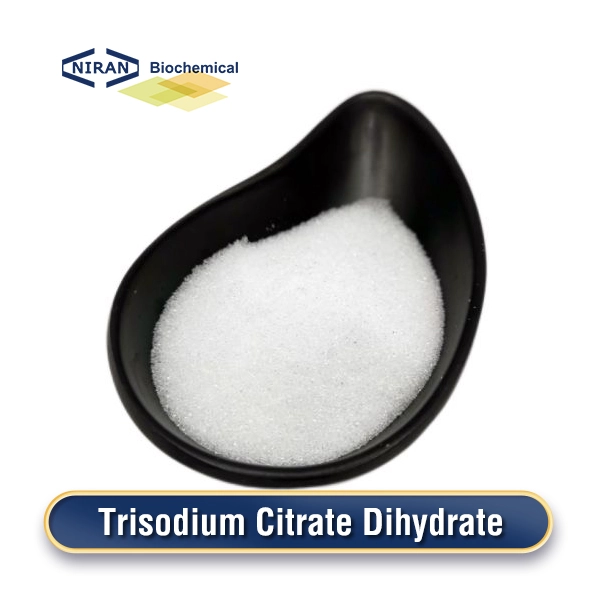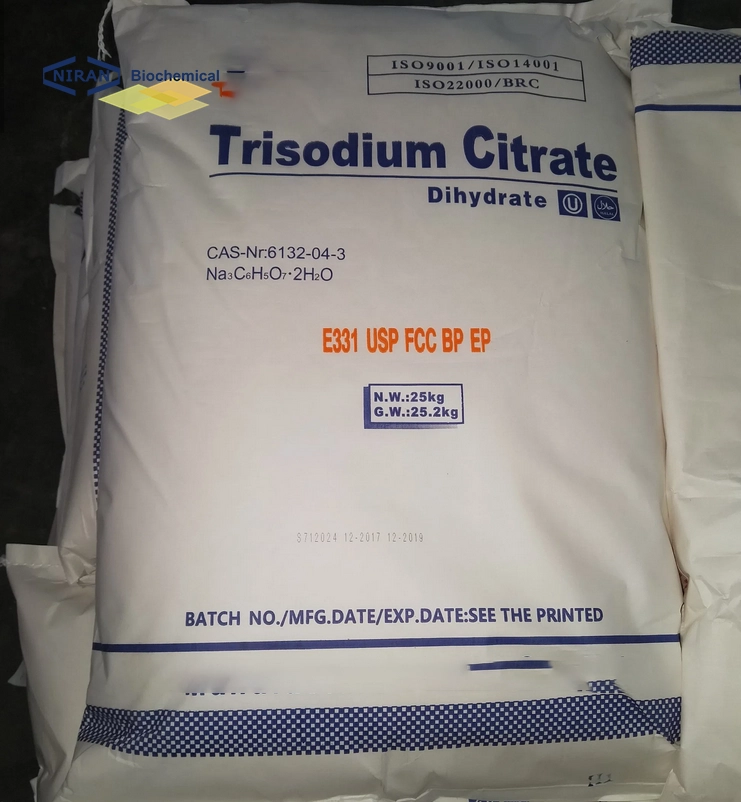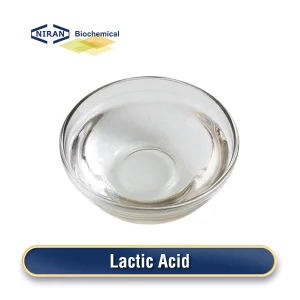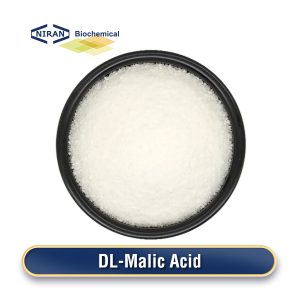Niran Biochemical
YOUR RELIABLE FOOD INGREDIENTS
Send Inquiry
Home » Products » Acidulants » Trisodium Citrate Dihydrate
Trisodium Citrate Dihydrate
- CAS: 6132-04-3
- Chemical Formula: C6H5Na307*2H20
- Certification: KOSHER, ISO, HALAL, FSSC22000, BRC, etc.
- Standard:
- MOQ: 1000KG
- Shelf Life: 3 Years
Inquire Product
Product Description
What is trisodium citrate dihydrate?
Trisodium Citrate Dihydrate is an organic compound, also known as trimethyl sodium citrate, which appears as colorless crystals or white granules or powder and is odorless and slightly salty. This substance has extensive applications in food additives, emulsifiers, and the pharmaceutical industry.
Trisodium Citrate Dihydrate is prepared by stirring sodium bicarbonate and dissolving it in hot water, then adding citric acid to neutralize it to a Ph value of 6.8 at 85-90°C, then adding activated carbon for decolorization, and filtering it while hot. The filtrate undergoes concentration under reduced pressure, followed by cooling and crystallization. The resulting crystals are then centrifuged, washed, and dried to yield sodium citrate.
The chemical formula is: C6H8O7+3NaHCO3→C6H5Na3O7·2H2O+3CO2↑+H2O
Another method is to use anhydrous citric acid dried at 70°C and anhydrous sodium carbonate dried at 160°C as raw materials. Dissolve 1 mol of citric acid in 600 mL of water, add a stoichiometric amount of sodium carbonate in small amounts several times, and stir continuously. Boil the solution for 30 minutes, then filter it. Collect the filtrate in an evaporating dish of known weight, and evaporate it in a water bath until crystals start to form and precipitate. The crystals are air-dried and then dried at 70°C.
Related parameters:
| Items | Standards |
| pH (aqueous solution 5%) | 8.0-8.7 |
| Loss on drying (Water) | 12.00-12.50% |
| Extraneous matter | Meets specifications |
| Heavy metals | ≤1 ppm |
| Arsenic | ≤1 ppm |
| Lead | ≤1 ppm |
| Mercury | ≤1 ppm |
| Copper | ≤1 ppm |
| Zinc | ≤1 ppm |
| Iron | ≤5 ppm |
| Calcium | ≤20 ppm |
| Magnesium | ≤2 ppm |
| Chlorides | ≤5 ppm |
| Sulphates | ≤30 ppm |
| Oxalates | ≤10 ppm |
| Tartrates | Meets specifications |
| Alkalinity | Meets specifications |
| Readily Carbonizable Substances | Meets specifications |
| Colour (250 g/l, Tat 366 nm, 1 cm) | min. 92% |
| Assay | 99.0-100.5% |
Recommended dosage:
| Food name | Maximum usage(g/kg) |
| Carbonated beverages | 0.5-1.0 g/kg |
| Starch products | 0.3-0.6 g/kg |
| Seasonings | 0.5-1.0 g/kg |
| Ham | 0.3-0.5 g/kg |
| Canned food | 0.4-0.8 g/kg |
| Leaning agent | 0.3-0.5 g/kg |
| Potato chips/French fries | 0.3-0.6 g/kg |
| Juice | 0.5-1.0 g/kg |
| Cheese | 0.4-0.7 g/kg |
| Bread | 0.3-0.5 g/kg |
Trisodium citrate dihydrate has a wide range of uses
1. It serves as a pH regulator and emulsifier in various products such as jams, candies, jellies, and ice cream. It can reduce the sour taste when combined with citric acid and can also complex metal ions.
2. It is utilized as a food additive, complexing agent, and buffer in electroplating, pharmaceutical anticoagulant production, and as a detergent auxiliary agent in the light industry.
3. It is employed as a chromatographic analysis reagent, in the preparation of bacterial culture media, and finds applications in the pharmaceutical industry.
4. It serves as a seasoning and stabilizer in food processing, a buffer and secondary complexing agent in non-toxic electroplating, and also finds use as an anticoagulant, expectorant, and diuretic in pharmaceutical applications. Additionally, it finds use in brewing, injections, and analgesics.
5. Check the acidity of urine. It serves as a multivalent complexing agent and sequestrant for removing trace metals, and functions as a buffer, bacterial culture medium, and blood anticoagulant. Additionally, it is utilized for food preservation and freshness, acts as an expectorant and diuretic in pharmaceutical applications, and finds uses in brewing, photography, and electroplating industries as a chelating stabilizer and detergent auxiliary.
6. Trisodium citrate dihydrate is employed in diverse applications including copper plating, pre-nickel plating, silver plating, tetrachromate chromium plating, copper-zinc alloy plating, gold plating, chemical nickel plating, and gold stripping solutions, acting as a complexing agent. In citrate nickel electroplating, it functions as a conductive salt and complexing agent to prevent nickel hydroxide precipitation. It is also used in electrolytes for copper plating, zinc plating, gold plating, and neutral nickel plating. Additionally, trisodium citrate dihydrate finds use in chemical nickel plating of cobalt and its alloys.
User asked question:
Q: Difference between trisodium citrate dihydrate and sodium citrate
A: Trisodium citrate dihydrate contains two crystal water molecules, so it is easier to dissolve in an aqueous solution, and it is widely used in the food industry. Due to its good chelation and stability, trisodium citrate dihydrate is used as a food additive and is often used in the production of sauces, jams, jellies, beverages, etc.
Trisodium citrate dihydrate can also be used as an antioxidant and acidulant for food, which can increase the flavor and taste of food; in addition to the food industry, it has many other application areas. For example, it is often used to adjust the value of drugs and stabilize the properties of drugs in pharmaceutical manufacturing. In addition, it can also be used as a formula ingredient in cleaners and detergents, with good decontamination and emulsification properties. Sodium citrate does not contain water molecules, so its solubility is low, and is widely used in the food industry.
Sodium citrate as an acidulant, it can increase the acidity and taste of food, and is often used in the production of carbonated beverages, juices, jellies, and other foods; in addition to its application in the food industry, sodium citrate is also widely used in pharmaceuticals, cosmetics, detergents and other fields. Due to its acidic properties, sodium citrate can be used to control the pH of drugs and as an acidity regulator in cosmetics. In addition, it can also be used as a calcium ion softener in detergents to help remove stains from clothing.
Q: Emergency measures for contact with trisodium citrate dihydrate
A: If inhaled, relocate the individual to fresh air. In case of contact with skin, please take off the clothes immediately and wash the skin surface thoroughly with soap or water. If you feel unwell, seek medical attention immediately; If contact with eyes occurs accidentally, open the eyelids, rinse with running water or saline, and seek medical attention immediately; If swallowed, rinse the mouth immediately, do not induce vomiting, and seek medical attention immediately.




